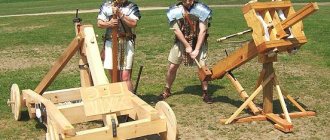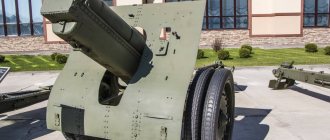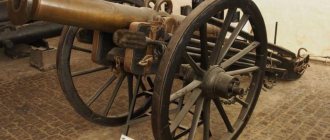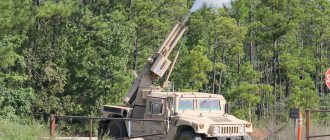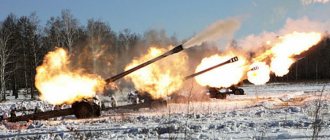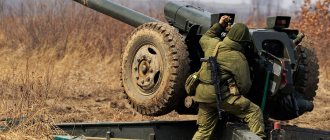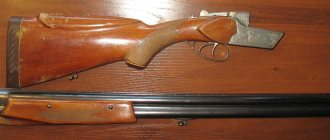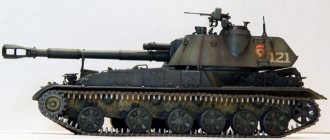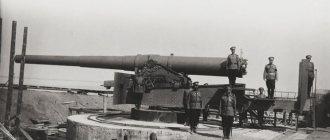Divisional gun ZIS-3 – video
https://youtube.com/watch?v=xAsqLGC334E
The ZIS-3 cannon no longer protects the borders of the Eastern Bloc states, but it is still in service with the armies of many Third World countries, including China, where a modification of the local production is designated 76-mm gun Type 54
In these countries, the ZIS-3 remains an important multi-purpose artillery system, but the successors of the former Red Army retained it only as a guard at the front gate and as a salute weapon. In some countries, in particular Romania, production of 76-mm ammunition for the ZIS-3 continues, although the potential market is constantly shrinking
Mounted on a carriage with sliding tubular frames, equipped with a large shield and having a long thin barrel, the ZIS-3 gun, in addition to performing field artillery tasks, was supposed to serve as an anti-tank gun - in particular, one modification was the 57-mm ZIS- anti-tank gun that appeared in 1943. 2, mounted on the same carriage as the ZIS-3. Another modification was the SU-76 self-propelled artillery mount, produced in large quantities, but now widely withdrawn from service. Since the ZIS-3 was the most common artillery system in the Eastern Bloc states, over the years a high degree of standardization of ammunition was achieved, surviving and to this day. The high-explosive fragmentation projectile was produced in the largest quantities, but other types included an armor-piercing projectile, as well as a cumulative projectile that appeared subsequently, capable of penetrating armor 194 mm thick at a direct shot range. The maximum firing range is 13,290 meters.
Creation stage.
In September 1937, the Artillery Department transferred the UZTM TTT design bureau for a new howitzer. As an initiative, design teams of design bureaus, head. No. 172 headed by F. Petrov and Grabinsk Design Bureau headed by. No. 92.
Plant No. 172 was the first to complete the task; its prototype howitzer with index M-30 arrived for testing at ANIOP on September 11, 1938. To reduce design time and simplify production, the design used developments in individual components of serial guns:
- The piston bolt was taken from a 122-mm howitzer mod. 1910/30;
- recoil brake, with the necessary design changes, from a 122-mm howitzer mod. 1934 (howitzer "Lubok");
- wheels from the F-22 cannon;
- The barrel bore was basically the same as that of the Lubok howitzer.
During testing, the 122-mm M-30 howitzer covered more than two and a half thousand kilometers and a little less than two and a half thousand rounds were fired from it. During the tests, the frames showed insufficient strength, which broke twice; the piston valve did not work reliably due to an error in the dimensions of the sleeves.
They could not collect a full charge of gunpowder from six differently weighted charges in one cartridge case; as a temporary measure, it was placed in a pair of cartridge cases.
The howitzer did not pass the test, but by decision of the commission it was recommended for military testing. A short time later, on November 27, 1938, the M-30, with improvements based on the results of the first tests, again entered the ANIOP. The M-30 howitzer was tested by the troops from 12/22/38 to 01/10/39. Army tests showed the same picture - weak frames, cracked welding, fluid leaks from the hydraulics.
The commission concluded that the 122-mm M-30 howitzer passed the test, there is no need for further military tests, but the identified deficiencies should be eliminated and field tests should be carried out. However, the gun underwent military testing once again, after the identified design defects were eliminated, in the summer of 1939, after which it entered service.
Where can you see[edit]
File:Pg3 m30 screenshot 1.jpg Screenshot of the computer game Panzer General III. A unit armed with an M-30 howitzer has been deployed
Due to the large number of guns produced, M-30 howitzers very often end up on display in military museums or are used as memorial weapons. In Moscow it can be seen in the Museum of the Great Patriotic War on Poklonnaya Hill and the Central Museum of the Armed Forces, in St. Petersburg - in the Museum of Artillery and Engineering Troops. Nizhny Novgorod, where plant No. 92, which produced the M-30 in 1940, is located, until recently did not have this howitzer either in city museums or as a monument weapon. However, in 2004, a new memorial complex was opened on Marshal Zhukov Square, where the M-30 was installed as a monument weapon. Along with other exhibits (BTR-60, ZiS-3 and D-44 guns), it enjoys constant interest from children (since the memorial is located inside a large residential area next to a children's clinic). In Finland, this weapon is exhibited in the Hameenlinna
, in Poland - in the Poznan Citadel, in Israel - in the
Beyt-ha-Totchan
.
Production of 122-mm howitzer mod. 1938
For serial production, the howitzer of the Perm design bureau was transferred to the Uralmash plant and plant No. 92. The latter produced only five hundred howitzers from the order of the forties and stopped their production.
Production volumes are similar to the production of other guns - a surge in production in the forty-second year to make up for the losses of the first year of the war. The subsequent decline is explained both by the need to produce guns for self-propelled guns and by the production program for the D-1 howitzer.
However, the quantitative growth of Soviet artillery did not mean its qualitative growth.
About 80 percent of Soviet artillery was 76-82 mm in caliber, and the role of mortars in artillery increased significantly to the detriment of howitzers and cannons. Production of 122 mm howitzers mod. 1938
| Year of issue. | 1940 | 1941 | 1942 | 1943 | 1944 | 1945 | 1946 | 1947 | Total |
| Release of howitzers. | 639 | 2762 | 4240 | 3770 | 3485 | 2630 | 210 | 200 | 19266 |
| Year of issue. | 1948 | 1949 | 1950 | 1951 | 1952 | 1953 | 1954 | 1955 | |
| Release of howitzers. | 200 | 250 | — | 300 | 100 | 100 | 280 | 100 |
Tactical and technical characteristics of the ZIS-3 gun
– Chief designer: V.G. Grabin - Years of production: 1941 - Issued, pcs.: 48,016
Combat crew: 6 people
Caliber, mm: 76.2
Dimensions of ZIS-3
– Barrel length, club: 40 (including muzzle brake), according to other data 39.3 (excluding muzzle brake) - Total length of the gun in the stowed position: 6,095 m - Width of the gun in the stowed position: 1,645 m
Weight of ZIS-3
– Weight in combat position, kg: 1200 - Weight in stowed position, kg: 1850
Firing angles
– Elevations (max.), °: 37- Depressions (min.), °: -5- Horizontal, °: 54
Firing range of ZIS-3
– Maximum firing range, km: 13.29
Rate of fire ZIS-3
– up to 25 shots/min
Design features and changes during production
Like most classical-type guns, the divisional howitzer mod. 1938 consists of the following elements:
- The barrel is a metal monoblock pipe, there is no muzzle brake. The barrel has 36 grooves.
- Breech, with piston lock. The barrel is screwed into a massive breech. A mounting system to the carriage is also installed on it.
- Carriage (M-30S – stand)
Components of the carriage:
- cradle;
- recoil devices;
- upper machine;
- aiming mechanisms;
- balancing mechanism;
- lower machine with sliding frames, there are also mounts for entrenching tools and spare parts;
- chassis, wheels with stamped discs and solid rubber tires;
- leaf springs;
- sighting devices;
- shield cover, made of several elements.
The frame cradle is placed with trunnions into special sockets of the upper machine. The socket of the lower machine includes a pin from the upper one, made with shock absorbers that hang the upper machine and make it easier to turn. The upper machine has rotating (left) and lifting (right) mechanisms.
Recoil devices consist of a hydraulic recoil brake (under the barrel) and a hydropneumatic knurler (above the barrel). A Hertz panorama was inserted into a special socket of an independent (two arrows) sight, through which direct fire and indirect fire were fired.
Over the entire production period, the howitzer underwent minor changes.
This is reflected in the 1948 Service Manual, but without issue numbers or dates. Changes were introduced to simplify and reduce the cost of production as much as possible. So around 1945, riveting on frames was replaced by welding. After modernization, the breech was increased in size and its strength was increased.
The trigger travel stop and the loading mechanism were removed. The grease fittings of the cradle rollers and the oil seals of the recoil and retractor brakes have undergone changes.
After the start of production of the 152 mm D-1, the carriage for two systems was unified. The design of sights and panoramas changed.
M-30 howitzer ammunition
The M-30 fired a full range of 122mm howitzer shells, including a variety of old Russian and imported grenades. After the Great Patriotic War, new types of ammunition were added to the range of projectiles listed below, for example, the 3BP1 cumulative projectile.
The 53-OF-462 steel high-explosive fragmentation grenade, when the fuse was set to fragmentation action, when it exploded, created about 1000 lethal fragments, the effective radius of destruction of manpower was about 30 m (data obtained using the Soviet measurement method of the mid-20th century). When the fuse was set to the high-explosive action of the grenade, after the explosion it left craters up to 1 m deep and up to 3 m in diameter. In the early 1970s, new 3OF24 ammunition entered service with the 122-mm howitzers 2S1, D-30 and M-30. Instead of TNT, composition A-IX-2 was used as an explosive, due to which the effectiveness of 3OF24 projectiles was increased by 1.2-1.7 times compared to 53-OF-462. Since 1982, the 3OF56 and 3OF56-1 projectiles of increased power have entered service with 122-mm howitzer systems.
The 53-BP-460A cumulative projectile penetrated armor up to 100-160 mm thick at an angle of 90° (different sources provide different data). The target firing range for a moving tank is up to 400 m. The post-war 3BP1 cumulative projectile penetrated at an angle of 90° - 200 mm, 60° - 160 mm, 30° - 80 mm.
The crew of a 122-mm M-30 howitzer fires at the enemy on one of the streets of Vienna.
Combat use
The M-30 was used for firing from closed positions at entrenched and openly located enemy personnel. It was also successfully used to destroy enemy field fortifications (trenches, dugouts, bunkers) and to make passages in wire fences when it was impossible to use mortars. The defensive fire of the M-30 battery with high-explosive fragmentation shells posed a certain threat to enemy armored vehicles. The fragments formed during the explosion were capable of penetrating armor up to 20 mm thick, which was quite enough to destroy armored personnel carriers and the sides of light tanks. For vehicles with thicker armor, shrapnel could damage chassis components, guns, and sights.
To destroy enemy tanks and self-propelled guns in self-defense, a cumulative projectile, introduced in 1943, was used. In his absence, the artillerymen were ordered to fire high-explosive fragmentation shells at the tanks with the fuse set to high-explosive action. For light and medium tanks, a direct hit from a 122-mm high-explosive shell was fatal in many cases, even leading to the turret being torn off its shoulder strap. Heavy "Tigers" were a much more stable target, but in 1943 the Germans recorded a case of causing heavy damage to tanks of the PzKpfw VI Ausf H "Tiger" type during a combat clash with Soviet SU-122 self-propelled guns armed with M-30 howitzers.
Crew of the Soviet 122-mm howitzer M-30 at a position on the Frische Nehrung Spit (now the Baltic Spit). 11th Guards Army.
The reasons for the appearance of the howitzer mod. 1938
The deployment of mechanized units and formations of the pre-war period, the tendency to transfer howling artillery to the mechanical thrust of war required the creation of artillery capable of accompanying and supporting mechanized infantry and tanks.
This required guns that had very specific combat qualities, which were insufficient in the howitzers that were in service at that time. First of all, this concerned such qualities as:
- power of a single shot;
- range;
- rate of fire;
- tactical mobility;
- fire mobility.
To ensure the required qualities, the basic requirements for the new howitzer were formulated as follows:
- caliber 122 mm . The issue of the caliber of a light howitzer was not self-evident. At this stage, the advantages of the 107-mm caliber in howitzer artillery were finally abandoned in favor of the greater power of the 122-caliber projectile;
- range _ The performance of the new howitzers was supposed to exceed that of the 122-mm howitzers mod. 1910/30 g;
- rate of fire To increase the rate of fire, at the very least, the gun should have been equipped with a wedge breech. However, manufacturing it for domestic industry was difficult. As a consequence, a wedge gate is only desirable;
- tactical mobility . The speed of the howitzer on the highway is at least 50 km/h. Which required at least suspension and metal rubber-coated wheels;
- fire mobility or maneuverability. To increase it, the howitzer had to have sliding frames and an air pressure angle of 65 degrees.
Sources of information[edit]
- Shirokorad A. B. Encyclopedia of domestic artillery
. - Mn.: Harvest, 2000. - 1156 p.: ill. ISBN 985-433-703-0 - Shirokorad A. B. God of War of the Third Reich
. - M.: AST Publishing House LLC, 2002. - 576 pp.: 32 l. ill. ISBN 5-17-015302-3 - Shirokorad A. B. The genius of Soviet artillery
. - M.: AST Publishing House LLC, 2002. - 432 pp.: 24 l. ill. ISBN 5-17-013066-X - Ivanov A. Artillery of the USSR in the Second World War
. - St. Petersburg: Publishing house "Neva", 2003. - 64 p. ISBN 5-7654-2731-6 - Shunkov V.N. Weapons of the Red Army
. - Mn.: Harvest, 1999. - 544 p. ISBN 985-433-469-4 - Zheltov I. G., Pavlov I. V., Pavlov M. V., Solyankin A. G. Soviet medium self-propelled artillery installations 1941-1945.
- M.: Publishing House LLC, 2005. - 48 p. ISBN 5-94038-079-4
Projectile consumption.
The average consumption rates for performing fire missions from closed firing points during frontal fire are as follows:
- To suppress an individual firing point outside a shelter at a distance of up to 4 km, 20-25 grenades of a 122-mm howitzer mod. 1938 with the fuse set to produce fragmentation within 15-20 minutes;
- to suppress manpower in communication passages and trenches, for every 10 m of trench, up to 40 high-explosive grenades are required at a distance of 2-3 km for 20-30 minutes and at a distance of 4-6 km - 60 grenades for 30-40 minutes;
- destroying a 10-meter trench requires the same number of shells as suppression, but over a longer period of time;
- to destroy a dugout with two or three direct hits at ranges up to 3 km, up to 120 grenades are required within 1 hour.
The listed tasks were carried out primarily by battery fire.
Direct fire for destruction should be carried out from ranges of 500-1000 m. At the same time, an average of up to 20 shells are spent on the destruction of field-type structures.
The 122-mm howitzer fights tanks from closed and open firing positions. From closed OPs - with massive fire - at areas where tanks are concentrated, at tanks in columns and advancing tanks - by conducting a mobile barrage.
When enemy tanks break through into the depths of the defense and reach the area of covered battery firing positions, the latter fire at them with direct fire.
The longest range of actual direct fire on BTT for howitzers mod. 1938 - 1500 m; at these ranges, fire should have been carried out only during massive tank attacks.
To increase the effectiveness of destruction and avoid premature detection of guns by the enemy, fire should be opened from a direct shot range of 9,600 m.
A cumulative projectile at a distance of up to 1000 m destroys armor up to 100 mm. At short ranges, high-explosive fragmentation shells are successfully used for firing at armored personnel carriers.
States.
In the pre-war period, the staff of the divisional artillery provided for the presence of light artillery. regiment consisting of 2 divisions (8 76 mm guns and 4 122 mm howitzers in each), howitzer art. a regiment of two divisions (12 122 mm howitzers in each) and a division of 152 mm howitzers (four howitzers). As we can see, the basis of the pre-war divisional artillery regiments were howitzers and guns of 122 mm caliber and higher.
Changes in the number of 122-mm howitzers using the example of wartime rifle division staff can be seen below.
Changes in divisional artillery of rifle divisions.
| Art system | July 1941 | December 1941 | March 1942 | July 1942 | December 1942 | July 1943 | December 1944 | ||
| regular | guards | regular | guards | ||||||
| 76 mm guns | 16 | 16 | 20 | 20 | 20 | 24 | 32 | 36 | 32 |
| 122 mm howitzers | 8 | 8 | 12 | 12 | 12 | 12 | 12 | 12 | 20 |
The motorized division had less artillery, its art. The regiment had two divisions of 4 76 mm cannons and 8 122 mm howitzers, and a howitzer division of 152 mm howitzers.
The tank division was armed with art. the regiment has only 16 122 mm howitzers and 12 152 mm howitzers.
From prerequisites to creation
Even before World War I, Russia purchased 48-line howitzers for the army - guns designed to fire heavy high-explosive shells. This type of weapon was specially designed to combat enemy fortifications.
For infantry hidden in trenches or behind a rampart, heavy shells flying along a steep trajectory are very dangerous. It should be clarified that in Russian units of measurement - 48 lines correspond to 4.8 inches or 121.92 mm, reduced to the usual 122 mm, this caliber is still considered optimal for light field howitzers.
Howitzers of the 1909-1910 model, developed by the Krupp concern and the French one, respectively, coped well with the responsibilities and tasks assigned to them. Moreover, the mass production of ammunition for them subsequently played a role in equipping the Soviet army.
At the end of the twenties, the artillery park of the Red Army became morally and physically obsolete.
The modernizations carried out in 1930 of the Krupp howitzers, and in 1937 of the French howitzers, could not satisfy all the requirements for modern artillery. The government's policy of mechanization in the army clearly showed all their imperfections.
Even moving without suspension and on wooden wheels faster than 10 km/h was impossible. And the firing range increased during modernization remained below the required one.
The “Journal of the Artillery Committee” in 1928 was the first to formulate the requirements for the next generation divisional howitzer. After publication, on August 11, 1929, technical specifications for its development were issued. It was decided to make the caliber within the range of 107-122 mm, based on the performance characteristics of English and German howitzers that have a similar purpose.
In addition, the gun had to be adapted for towing by mechanized means.
A separate point included the possibility of maneuvering a gun on the battlefield by crew forces.
The theme of creating a new weapon was called “Lubok”. There were not enough developers of our own; the Civil War greatly decimated competent engineering personnel. It was necessary to entrust the work on "Lubok" to German specialists from the Weimar Republic who served in KB-2, which structurally belonged to the All-Union Weapons and Arsenal Association of the People's Commissariat of Heavy Industry.
It should be noted that the help of German specialists was invaluable at that time, since the country of the Soviets lacked not only engineers, but also production capacity. There were difficulties even with machine workers.
The result of the work was a 122 mm howitzer on a single-beam carriage. Sprung metal wheels made it possible to reach speeds of up to 10 km/h, because the use of tires was not provided. The vertical angle of the barrel (length 23 caliber) did not exceed +50°, and the horizontal angle – 7°. In the stowed position the system weighed 2.8 tons, in combat - 2.25 tons. For those times, a pretty good result.
However, the material and technical capabilities of the factories were not taken into account. Only 11 howitzers were produced. The Nazis' rise to power in Germany led to the liquidation of KB-2. In 1936, the project was closed because the requirements for modern guns changed.
The artillery department demanded the creation of a howitzer with rubber wheels for the Red Army.
The carriage must be designed with sliding frames. The rubber travel and suspension made it possible to increase the towing speed of the gun; the sliding frames, in turn, made the structure heavier, but gave the gun greater fire maneuverability.
Again we considered calibers 107 and 122 mm, but with the requirement to increase all aiming angles. It was assumed that it was even possible to make a howitzer-gun. The 122 mm caliber won, although the production of 107 mm guns would have been much cheaper.
The fact is that the arsenals had accumulated a large stock of shells for 122 mm guns; in addition, unlike the 107 mm shell, which had to be developed and created almost from scratch, for the production of 122 mm shells and charges there were ready-made and operating production lines.
Such weapons have more power. The new concrete-piercing projectile also required a large caliber. Thus, the next step was the creation of the legendary M-30.
